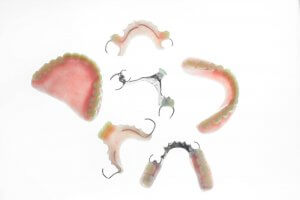Are you concerned about your missing teeth and looking for solutions, or maybe even the cheapest way to replace missing teeth? For adults, missing permanent teeth can cause problems with eating, speaking and appearance, to mention just a few—so it’s good to consider the options for replacing missing teeth.
You’re certainly not alone with this problem, though. Recent dental statistics estimate that 178 million Americans have at least one tooth absent, and about 40 million Americans have no teeth at all!
There are several solutions that can replace a missing tooth, some cheap tooth replacement options, others more expensive, but each has its own pros and cons. You’ll need to consider what’s most important in terms of:
- Cost
- Aesthetics
- Durability
- Comfort
- Convenience
In this guide, we’ll explain the different options for the cheapest way to replace missing teeth, and find out how much it is to get a fake tooth, so you can decide which is best for you whether you’re missing a front tooth, back tooth, or several.
Is replacing a missing tooth necessary?
If you are one part of the 75% of Americans missing all or part of a tooth, you probably already understand some of the problems that this can cause, and replacing a missing tooth is the best option. A missing tooth can lead to:
- Difficulty eating certain foods
- Self-consciousness over appearance, especially with a missing front tooth
- Increased risk of damage to surrounding teeth
- Speech problems
- Other teeth becoming crooked
- Greater likelihood of gum disease and cavities
- Deterioration of jawbone, which can make the face sag over time (worse when several are missing)
It’s a cosmetic disaster and the root of some unpleasant stereotypes, but the health effects of missing teeth are many and potentially serious. People risk increased damage to surrounding teeth, gum disease, cavities, the deterioration of the jawbone and even malnutrition:
- The mouth is a critical part of the digestive process.
- When a person can’t properly chew their food they are seriously taxing their gastrointestinal system.
- Acid reflux and a host of other digestive issues can erupt.
- For every five teeth lost, a person is nearly one and a half times more likely to show decreased intake of vital nutrients that can lead to malnourishment.
Dr. Hunter Dawson, Carolinas Center for Oral, Facial, Cosmetic & Dental Implant Surgery
If you are missing a back tooth which isn’t really visible, you might not feel like it’s a big issue. However, the longer you have gaps in your mouth, the more likely it is that there will be negative consequences for your oral health.
So even if you don’t notice any immediate missing teeth problems, it’s worth considering your options for replacing a missing tooth to protect your mouth from damage later on.
The following animation shows how not treating a single absent tooth can affect other healthy ones:
Reasons for missing teeth
Missing adult teeth can occur for several reasons. It might be an accident or injury which knocked out a tooth or damaged it beyond repair. Tooth decay and gum disease may also advance to where teeth fall out or you need a tooth extraction.
And did you know it’s possible to have absent teeth because of a genetic condition called hypodontia? Also known as ‘congenitally missing teeth’, hypodontia causes one or more of the 20 baby teeth or 32 adult teeth to be absent.


It’s often the wisdom teeth that are affected by hypodontia, in which case missing tooth replacement isn’t necessary. But for those who are missing one or more of their other adult teeth, often the second premolar or lateral incisor, this can cause problems if they are not replaced. You can learn all about hypodontia in our article here.
Treatments for replacing missing teeth
Now let’s look at the various dental options for a missing tooth:
- Teeth implants
- Bridges
- Dentures
- Veneers (in some cases)
- Braces
If several teeth are absent in different positions, and you are considering your missing tooth options, a combination of these treatments may be the optimal solution to fix missing teeth.
Dental implants
Dental implants are the replacement tooth option that’s closest to a real tooth. This is because the metal implant is inserted into the jaw bone, performing some of the same functions as a tooth root. It fuses with the jaw bone to prevent bone loss and changes to the shape of the face.
An implant can support a single tooth crown, or two dental implants can support a bridge of three to four teeth.
This is the most expensive option for replacing missing teeth, but it’s also very long-lasting. Implants should look and feel like normal teeth once they are in place. You’ll need to take care of them with proper brushing and flossing, but there is no special cleaning required.
Read all about teeth implants here or use our price calculator to get an idea of costs for the dental implants you need:
Total estimated cost
All-on-4 implants for replacing all teeth
If you’re lacking all the teeth in one or both jaws, or if any remaining teeth are in poor condition, All-on-4 implants are a more affordable alternative to traditional implants. Using just four or six implants in each jaw, a full set of missing teeth replacements can be attached (know as implant dentures).
If you need replacements for all your teeth, this option is more expensive than dentures, but it is also much longer-lasting and should let you eat like normal.
If you’re looking for specific companies known for providing dental implants, including all-on-4s, you can check out our articles on G4 by Golpa, and ClearChoice reviews.
Dental implants look and function just like natural teeth and are the only type of replacement teeth that are embedded into the jaw bone. These artificial tooth roots stimulate the jaw bone the same way natural tooth roots do which keeps the bone healthy. This solid foundation enables the implant to function like a healthy tooth while remaining securely in place.
It’s also important to keep in mind that a dental implant is a complete restoration. There is no special dental care necessary – just brush and floss like you always do – and the implant’s foundation will allow you to enjoy your favorite foods without worry. The crown is also designed to match the shape and color of your other teeth for beautifully natural-looking results. With proper care, your implant can last a lifetime.
Dr. Sukhdeep Dhaliwal, DDS, MD, FACS – Kitsap Oral, Maxillofacial & Dental Implant Surgery
Dental bridge
A dental bridge is a kind of fake tooth that’s supported by the neighboring healthy teeth, like three or four crowns joined together. The supporting teeth have to be filed down slightly for the bridge to fit over the top, then it’s secured with an adhesive.
It’s also possible to get a bonded bridge with ‘wings’ that fix to the adjacent teeth. This is preferable if the teeth are in good condition and you want to avoid removing healthy enamel.
Bridges are a good balance between price and durability, and they should look like natural teeth. A bridge can only replace up to two teeth at a time, so if you’re lacking several in a row, then you’ll need to consider another option.
See our dental bridge guide for more information about this treatment.
Dentures


Dentures are usually the cheapest way to replace missing teeth or even a full mouth of teeth. Also called “false teeth”, these cheap tooth replacements are removable appliances with any number of fake teeth attached to a wire and acrylic frame.
Some people live happily with dentures, but others find them uncomfortable and have problems with them slipping out of place. Thus, you may opt for dentures as a temporary treatment option while saving money for a more permanent solution.
You may also want to check out options like flexible dentures, which are said to be more comfortable than normal dentures.
If you’re trying to decide between dentures and implants, be sure to check out our article here that compares the two.
Veneers
Occasionally it’s possible to use veneers to fix missing teeth, but only if there is a tiny gap left between two teeth. A veneer, either composite or porcelain, is applied to the teeth on either side to “fill in” the gap. In most cases, this is not a recommended missing tooth replacement option.
Want to know more about how veneers, implants, and bridges are crafted? Read more about CAD/CAM dental technology here.
Braces
Treatment to replace a missing tooth may also involve orthodontic work. If you have had a tooth gone for a while, the other teeth may have moved out of alignment. Braces can bring the remaining teeth back into their proper position before replacing the ones you are missing.
This may be an optional part of your treatment, but remember, having straight teeth is not just about esthetics; it also makes it easier to maintain good oral hygiene. Your dentist will explain your treatment options and outcomes.
Snap-On Smile for missing teeth
Snap-On Smile is a system that gives you a set of straight, white teeth that you can put on over your natural teeth. It is non-invasive, so no drilling or change to tooth structure, but it should only be used on special occasions or you might risk harming your natural teeth.
If you’re missing teeth, it can make it difficult to chew and talk each day, along with really affecting your self confidence. However, you have options for replacing missing teeth. Common options include:
- Implant restorations: this option is best for people who are missing teeth because of injury, gum disease, or any other reason. An implant is a metal post that is surgically positioned into the jaw to replace the root of a lost tooth.
- Partial dentures: these are used when some natural teeth remain.
- Full dentures: for if you have to replace all the teeth in one or both arches (upper and lower).
- Implant retained dentures: unlike conventional dentures, these partials are anchored to fixed titanium posts embedded in the jawbone that mimic natural tooth roots.
Dr. Ashley Niles, Niles Family Dentistry
What does replacing missing teeth cost?
How much is it to get a fake tooth? It depends on the type of replacement, the clinic, and your insurance. Replacing a missing tooth can cost from $300 to $6,000+. In the table below, you can see a summary of the treatment options discussed above, as well as approximate costs for replacing missing teeth in these ways:
Implant + crown/bridge/denture | Dental bridge | Removable denture | |
Permanency | Implanted in the jaw bone, fixed in place | Fixed to adjacent teeth; non-removable | Removable |
Longevity | 20+ years | 5–15 years, possibly longer | 5–10 years, possibly longer |
Comfort | Like natural teeth | Like natural teeth if fitted well | May become loose over time and cause discomfort |
Appearance | Like natural teeth | Like natural teeth (unless metal) | May look artificial; metal clips may be visible |
Function | Like natural teeth | Like natural teeth | Certain foods must be avoided; remove to clean |
Cost (private) | High: $1,500–$6,000 for a single implant | Medium: $500–$1,500 per unit | Low: From $300 |
Other pros/cons | Involves surgery; small risk of infection | Requires removal of enamel on neighboring teeth | Can slip out of place; easy to lose or damage while removed |
Missing tooth replacement options on insurance
As you can see from the cost-comparison table above, quality options for replacing missing teeth are pricey. Thankfully, there are dental insurance plans that can help you cover some of those costs.
Some plans that cover implants can cover 30% to 50% of the costs. That being said, no insurance plan is perfect and you will have to decide how much you are willing to pay for different levels of coverage.
If dental insurance isn’t the best way for you to cover the cost of your implants, consider a dental discount, or savings plan. These plans provide discounted dental treatment in exchange for a yearly membership payment.
For help to find either a dental insurance plan, or a dental discount plan for your implants, you can go to Dentalinsurance.com. This online marketplace makes it easy to search for the best dental plans in your area.
They also provide plenty of helpful information and videos explaining the different terms so you know exactly what you’re looking at. And if you need extra assistance, you can call 888-626-0057 to speak with one of their friendly licensed agents.
Medicaid may cover dentures and bridges, if they are medically necessary, and depending on the state you live in. Your Medicare Advantage plan might help cover the costs as well.
Read our article on Medicare and dental Medicaid to find out more about state and federally-funded health insurance.
How to replace a missing tooth cheaply
If you’re on a tight budget but don’t want removable dentures, there are other ways to make dental implants more affordable.
One popular option is to travel abroad to a country like Mexico, Hungary or Turkey where high-quality dental care is much cheaper than in the US. Patients can save 50-70% on their dental costs this way. To see if this would be a good option for you, check out our guide to dental tourism.
If you can’t get the money to pay for your implants, you can also consider taking out a dental loan. With a dental loan, you get all the money you need to pay for your implants upfront, and then you pay back the loan, usually with interest, in installments over time.
You can get started looking for a dental loan with the SuperMoney loan search engine.
We also have a separate guide with more ways to save on dental implants and other dental care.
Best solutions for when you are missing a tooth
Replacing a single tooth


If you can afford it, a dental implant is a natural-looking and long-lasting way to replace a single tooth without affecting either of the neighboring teeth.
However, both dentures and bridges are suitable ways to replace a single missing tooth as well. They may not last as long as an implant, but they are more affordable.
Multiple teeth missing
Dentures are one of the cheap tooth replacement options for multiple teeth. Even if you only have a handful of healthy teeth remaining (or none at all), a removable denture can fill in the gaps and let you eat and speak like normal.
An implant bridge can be used for three to four teeth in a row, while full mouth implants provide a full jaw of missing teeth replacements.
Options for missing front tooth vs. options for missing back teeth
If you have a missing front tooth, esthetics become a more important factor when choosing your treatment. Are you wondering how to fix a missing tooth in front?
Ceramic bridges and implants, when made well, can blend with your natural teeth. Acrylic dentures don’t look quite so natural. It’s possible to get ceramic dentures, but this increases the price significantly.
Another issue with dentures is that some metal wire clips may be visible, depending on the design. So the best option for missing front teeth is implants or a bridge, in terms of esthetics.
Since back teeth are less visible, you can consider dentures or partial implants for missing back teeth solutions. Additionally, acrylic dentures, as a missing back teeth replacement, is a good option if you are interested in something more affordable.
Conclusion
There are several ways to replace a missing tooth and we hope this guide has helped you work out which option would suit you best.
One thing we don’t recommend is doing nothing. Even if having a tooth missing isn’t bothering you now, leaving the gap in your mouth could lead to more problems in the years to come. Your dentist or prosthodontist will be happy to discuss all the dental options for missing teeth with you.
If you want to learn more about the edentulous population in the US, you can read our post about the percentage of Americans who are missing teeth.
FAQs
What is the cheapest way to replace missing teeth?
Dentures, or false teeth, are typically the cheapest way to replace missing teeth. These cheap tooth replacements are removable appliances with any number of fake teeth attached to a wire and acrylic frame.
Can missing teeth cause health problems?
Yes. The longer you want to replace missing teeth, the greater the risk for health problems like gum disease and tooth decay.
What is missing teeth called?
Missing teeth is also called tooth agenesis. It is a genetic disorder that can occur as part of other abnormalities.
NCBI: Congenitally missing teeth (hypodontia): A review of the literature concerning the etiology, prevalence, risk factors, patterns and treatment. Consulted 31st July 2019.
Hindawi: Hypodontia: An Update on Its Etiology, Classification, and Clinical Management. Consulted 31st July 2019.
thebmj: Austin Powers bites back: a cross sectional comparison of US and English national oral health surveys. Consulted 31st July 2019.
ACP: Missing Teeth. Consulted 14 August 2019.
Sunstar: Global Healthy Thinking Report. Consulted 11th September 2021.




